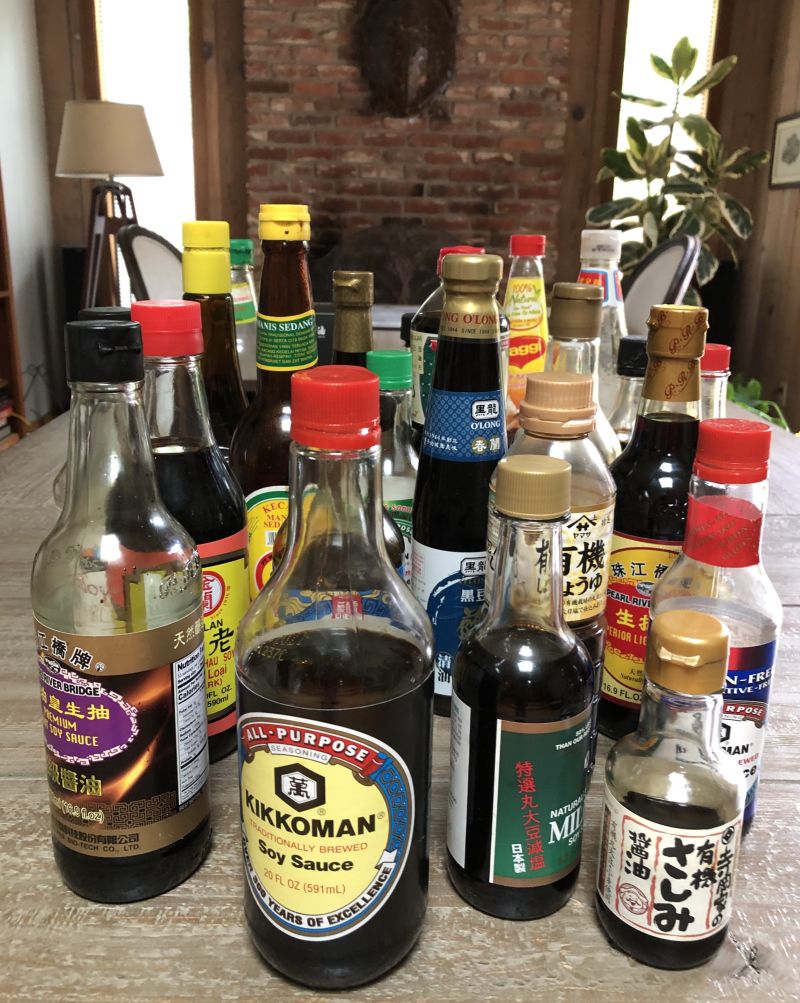
Hello, my name is Andrea and I've got a thing for soy sauce. Yesterday, I dove into my pantry (a hall closet) to look for dried chickpeas but realized that I had none. What I did come across was a wealth of soy sauce. I keep half a dozen bottles in the kitchen and over the years, out of curiosity and working on recipes for different cuisines, I amassed nearly 30 different bottles. My husband suggested that I cull my collection. I'm not sure about that, but instead, I wrote this soy sauce buying guide.
It's hard to buy soy sauce at an Asian market because there are so many. At regular supermarkets, the brands are limited but you may be confused by shoyu, tamari, light soy sauce, and low-sodium soy sauce. Then there are gluten-free and soy sauce-like condiments.
Soy sauce is used in East and Southeast Asian cuisines. There are variations and while this article isn't exhaustive, I hope it covers a lot of territory for your needs. Here we go!
Regular Soy Sauce
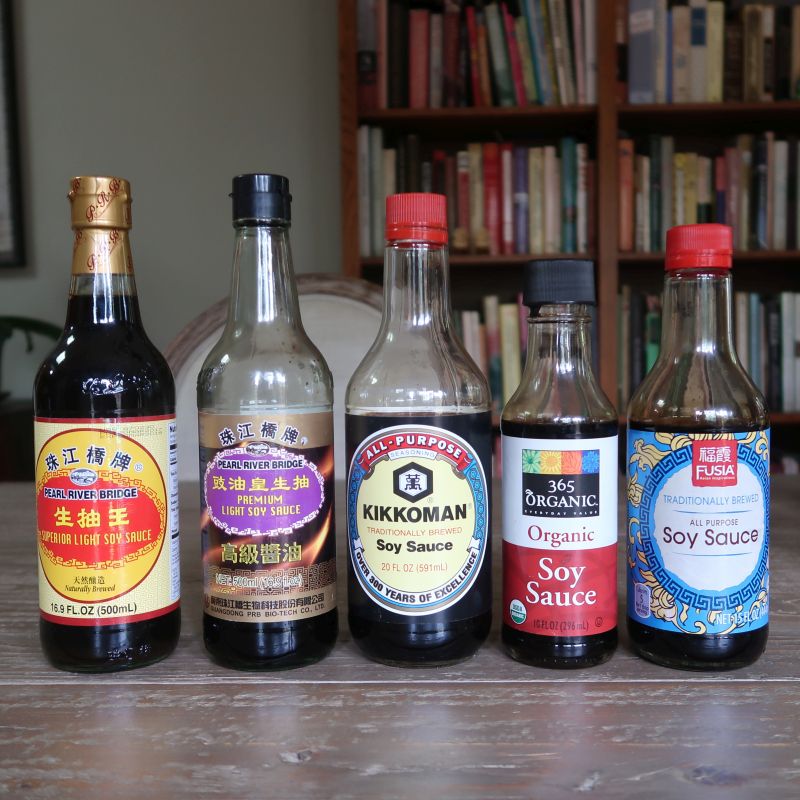
When a Chinese or Southeast Asian recipe calls for soy sauce, it means a regular, Chinese-style light soy sauce (called sheng chou in Mandarin; xi dau/nuoc tuong in Vietnamese). This is the most common type of soy sauce, what is stocked most at Asian markets and mainstream grocers.
"Light" soy sauce is not low in sodium but rather light in color. It’s saltier and thinner in consistency than dark soy sauce (see below). Sometimes regular light soy sauce is called thin soy sauce.
A well-stocked Chinese market will have many kinds of special light soy sauces, including one for steaming fish! You'll go far with a regular bottle of light soy sauce. Most soy sauce contain wheat for good flavor so read the label carefully if you have a wheat allergy. See the gluten-free discussion below for more.
Selection tips: A little darker than regular Chinese-style soy sauce, Kikkoman soy sauce is a good all-around soy sauce, especially if you're shopping at a regular supermarket. Pearl River Bridge is very good, especially its Gold Label or Premium Label which has been aged a bit longer. Amoy and Lee Kum Kee are terrific too. Some soy sauce, particular ones from Taiwan, have a sweetness due to sugar being in the formulation. Soy sauce from China and Hong Kong have a saltier finish because there's usually no sugar involved.
Gluten-free La Choy soy sauce is readily available at many supermarkets and its flavor is like a cross between regular soy sauce and Maggi seasoning sauce (see below).
Recipes to try: Mapo tofu, Vegetarian mapo tofu
Premium Soy Sauce
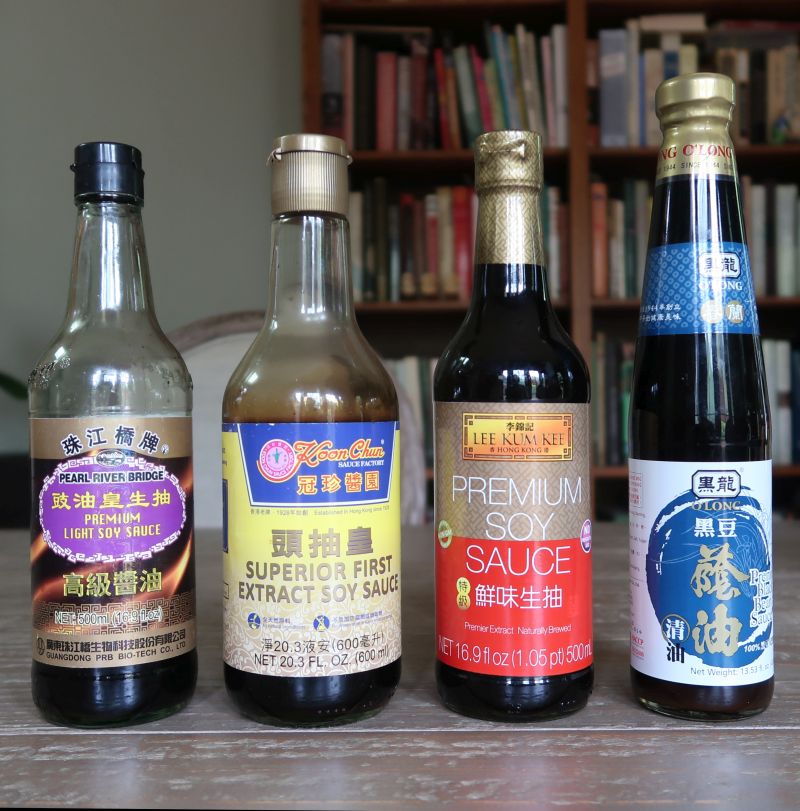
Once that you've chosen a favorite brand of soy sauce, check out their premium versions. The price difference is relatively small and the flavor is likely to be deeper and more complex. I regularly use the Pearl River Bridge Premium Light Soy Sauce in my cooking.
The Koon Chun is intensely darker. Lee Kum Lee is elegant with a touch of sugar; it's sometimes sold at regular mainstream supermarkets. Made in Taiwan to fit the island nation's cuisine, the one on the far right is sweeter than others. The availability and range of premium soy sauces depends on where you shop.
Gluten-Free Soy Sauce
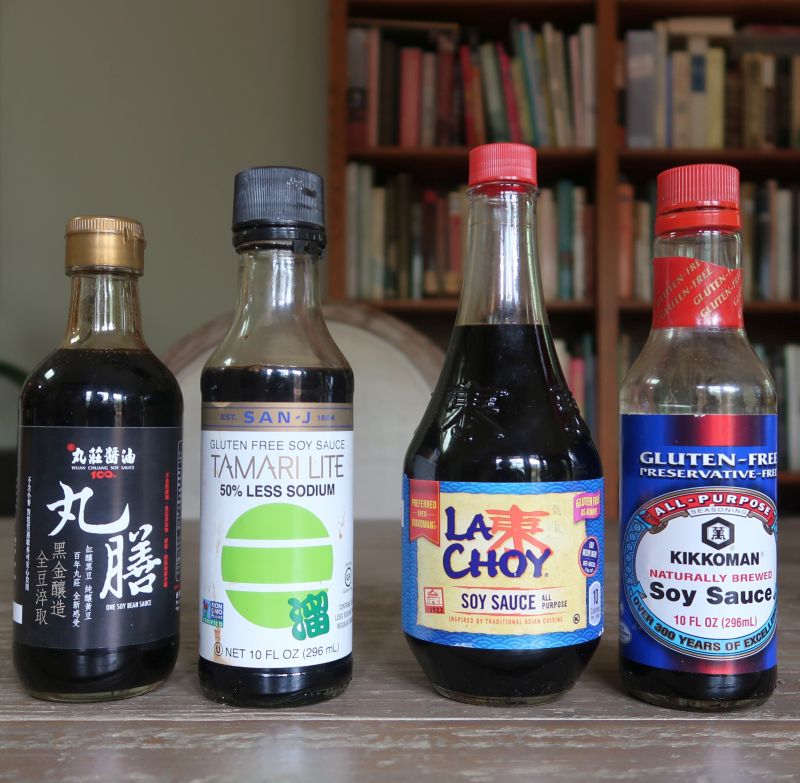
If you cannot eat wheat, then opt for a gluten-free soy sauce. They are not created equal. Jump to this blog post for a gluten-free soy sauce and tamari tasting. The bottle on the far left is a thick, salty-sweet, elegant Taiwanese soy sauce by Wuan Chuang that's called "One Soy Bean Sauce"; the same company makes Maruso soy sauce sold in the States.
Low-Sodium Soy Sauce
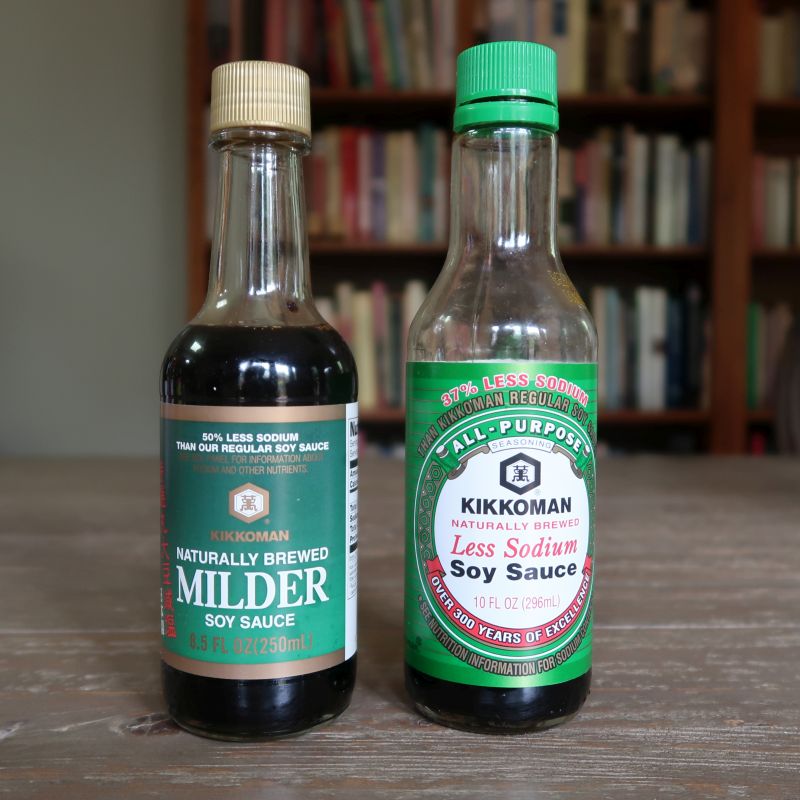
American magazine recipes often call for low-sodium soy sauce. Unless the publication is a health oriented one, I'm not sure why the condiment is called for.
The flavor of low-sodium is different than that of regular (light/thin) soy sauce. In my recipes, simply cut the regular soy sauce used by one-third (33%) or one-quarter (25%); add water to make up the difference. If you're used to the flavor of low-sodium soy sauce, use it!
Dark Soy Sauce
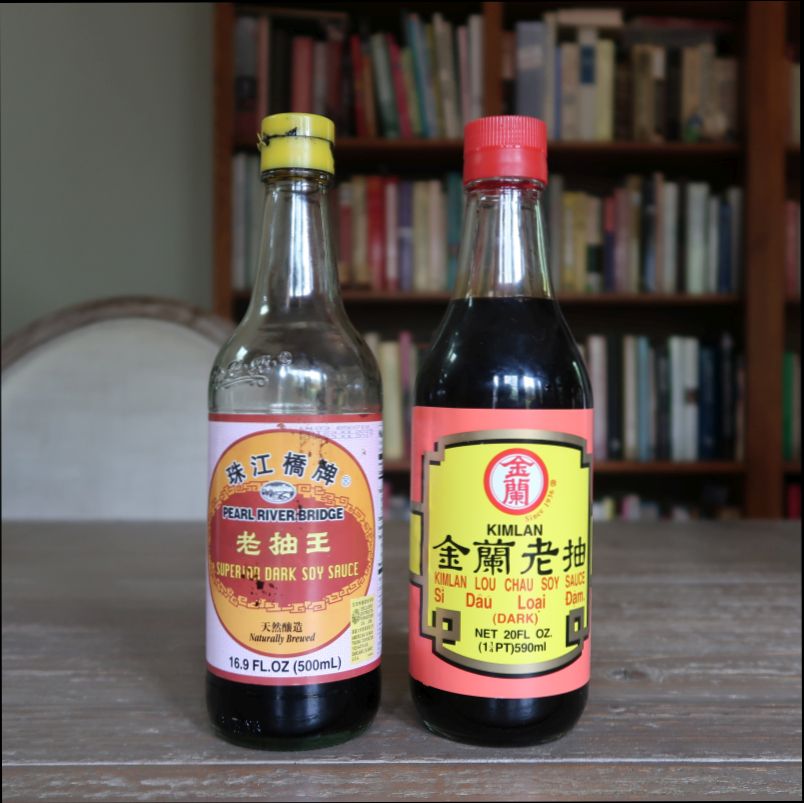
Compared to everyday regular (light/thin) soy sauce, dark (thick/black) soy sauce is less salty and inky. It has been aged and contains molasses to give it a distinctive slightly sweet taste and thick consistency.
Dark soy sauce (lao chou in Mandarin; hac xi dau in Vietnamese) is mostly used to impart a rich mahogany color to foods. It is typically added during cooking.
Special types of dark soy sauce include mushroom soy sauce that is flavored by straw mushroom. Black and double black soy sauce are extra dark and thick but slightly saltier than regular dark soy sauce. Thick soy sauce is super thick and may be jarred.
If you use any of these other dark soy sauces, tinker with your seasonings to get a balanced flavor. Most recipes employ regular dark soy sauce. Experiment and then pick one to use over time to ensure consistent results.
If you don’t have dark soy sauce, combine regular soy sauce and molasses in a 3:1 ratio.
Selection tips: Whatever brand of regular (light) soy sauce that you use, try that brand's dark soy sauce as they are likely to be copacetic. Pearl River Bridge and Koon Chun are reliably good. Thai cooks favor Golden Boy and Dragonfly brands.
Recipes to try: Kung Pao Tofu, Vietnamese grilled lemongrass pork
Japanese and Korean Soy Sauce
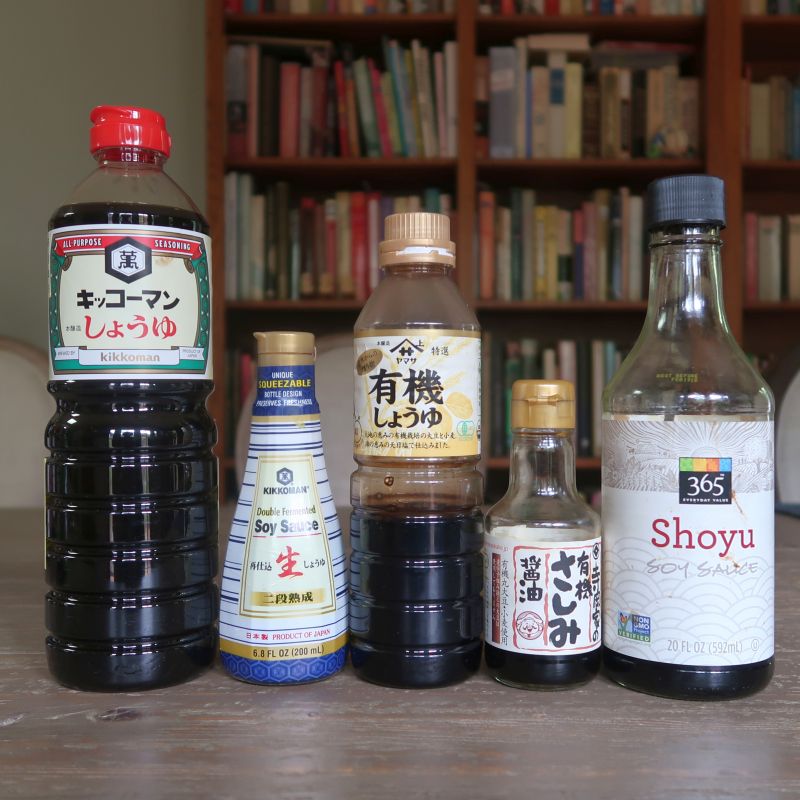
For the most part, Japanese and Korean soy sauces are interchangeable. They are both darker and slightly sweeter than Chinese-style light soy sauce.
Regular Japanese soy sauce is technically called koikuchi shoyu and is made from soybeans, wheat, water, and salt. Most people know it as shoyu and it is easier for cooks to obtain abroad than its Korean cousin, ganjang. You have to go to a Korean market for that whereas shoyu is widely distributed.
When substituting, some Korean cooks say that low-sodium Japanese soy sauce is closer to authentic Korean soy sauce. It does not matter much as long as you tweak the flavors according to your taste.
At a Japanese market, you’ll see light soy sauce (usukuchi shoyu) which is not low sodium, but rather light in color. In fact, Japanese light soy sauce is saltier than its dark counterpart. There are also high-end shoyu for sushi too, such as the little squat bottle in the photo.
Tamari is very dark and is mainly for dipping or basting sauces. It is made nearly entirely of soybeans and is fermented like miso; some tamari contain wheat while others do not. Read labels carefully if you have wheat allergies.
Selection tips: Imported Japanese and Korean soy sauce tends to taste the best. For example, Kikkoman soy sauce made in Japan tastes more refined than US-made Kikkoman. Excellent organic shoyu is also exported abroad. Raw, unpasteurized nama shoyu is fabulous too.
Recipes: Japanese seasoned soy concentrate (banno joyu), Korean shrimp dumplings, Japanese air-fried chicken, Korean beef and tofu patties
Sweet Soy Sauce
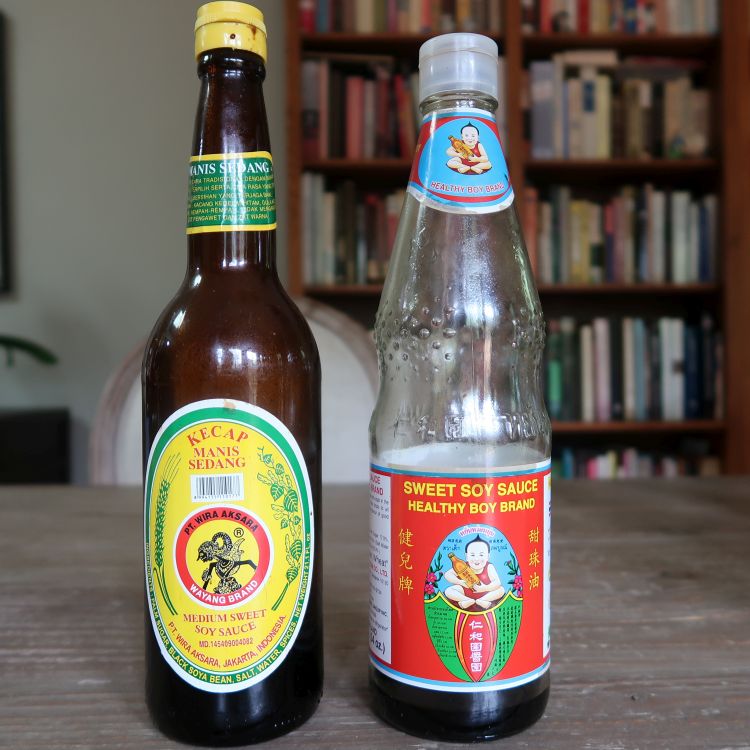
This thick, sweet slightly savory soy sauce is the stealth ingredient in many Indonesian dishes; it is used in Malaysian and Singaporean foods too but not as much. Thai sweet soy sauce is not as thick and complex in flavor as the Indonesian variety. In any event, once you’ve tasted sweet soy sauce, you may wonder how you’ve lived so long without it!
Called kecap manis, Indonesian sweet soy sauce is used in marinades and stews but it’s mostly employed at the table and for dipping sauces. Try mixing it with fresh lime juice and chiles. Drizzle it over a plate of fried rice or fried eggs.
With a texture that’s between molasses and honey, the condiment is made from soy sauce and dark palm sugar (gula jawa). In a pinch you can simmer soy sauce with palm sugar or dark brown sugar until it is syrupy.
Finally, kecap comes from Cantonese koechiap (sauce) which is where we get the term ketchup. Extensive trade between China and Indonesia brought the Chinese term to the spice islands
At Chinese and Southeast Asian markets in soy sauce, vinegar, and oil aisle; and other Asian foods section
Selection tips: Look for the tall dark bottles and brands such as ABC and Cap Bango. Indonesian sweet soy sauce that has no preservatives or additives has better, more complex flavors.
Recipes: Spiced Siamese peanuts, Thai stir-fried chicken and basil, Tofu and egg pancakes
Maggi Seasoning Sauce and Other Similar Condiments
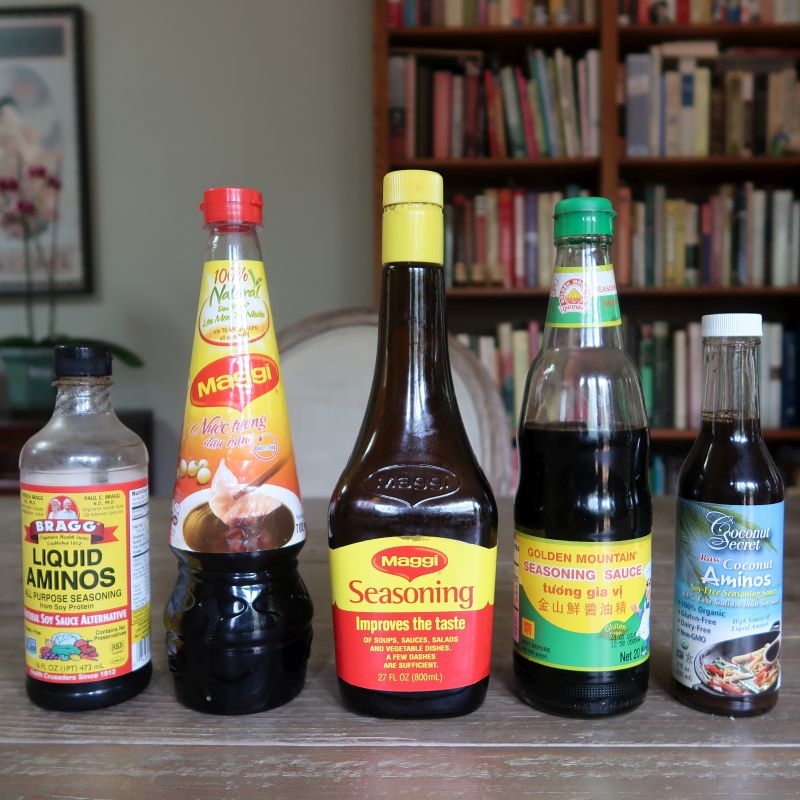
Maggi is popular with many Asian cooks and the bottle in the center is made in China. The one in the tall plastic squeeze bottle is made in Vietnam. It's so ubiquitous that some people in the country consider it as soy sauce; the flavor is lighter than the Chinese variety.
The Golden Mountain condiment is a Thai version of Maggi. Yup, Maggi is so popular in Southeast Asia that there are knockoffs (get the lowdown via this post).
Coconut aminos is similar to Maggi but has a slightly tart finish on the palate. Bragg Liquid Aminos is a fine Maggi substitute that's available at mainstream grocers. Bragg is gluten-free and non-GMO, if those things matter to you.
Choosing soy sauce
The most important thing for you is to choose a brand or brands that you like. There are differences in soy sauce flavors and uses. You do not have to be a fanatic like me. A regular soy sauce made in China, Hong Kong, Japan or Korea will be fine. Kikkoman is made in the States. The important thing is to know their differences so you may use them wisely.
Soy sauce prices can be affordably low or luxuriously high. If you shop at a well stocked Chinese, Japanese or Korean market, you may see a wide price range. Buy up in price and see if the condiment boosts your cooking!
Storing soy sauce
I keep them in my pantry, where it's cool, dark, and dry. If you're concerned, refrigerate the bottle. Some of the ones I've written about here have been aged through my negligence and they still taste great!
If you have questions, feel free to ask! Or, do you have a favorite brand or style to contribute? Don't hold back.















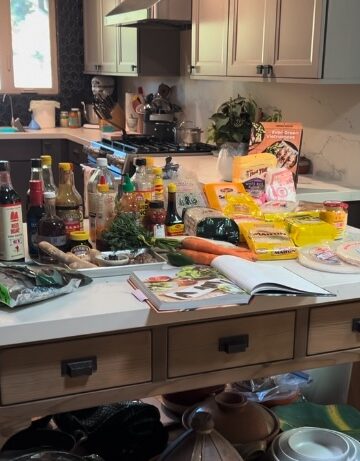
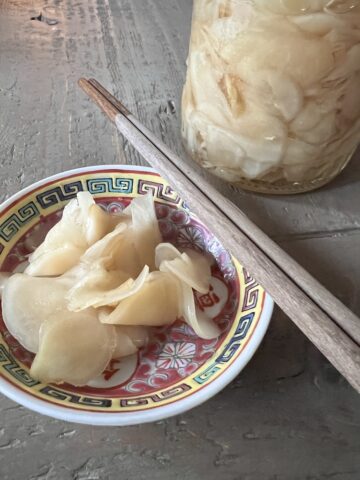
Michael Carter says
Mushroom flavored soy sauce is great in beef dishes. Bonito flavored soy sauce is also worth trying out. I use them in gravies and sauces and people rarely identify soy sauce as one of the ingredients.
Andrea Nguyen says
Thanks for the bonito soy sauce tip. I'll look out for it.
Forbes PERKINS says
This a helpful guide. My vegan friends all insist on Nama Shoyu which I dutifully buy but am a little stumped. Are you familiar with it and what is your opinion?
Andrea Nguyen says
Why do the vegans prefer nama shoyu? It's simply unpasteurized soy sauce. The only one I've purchased and tried came from a Japanese market and it was lovely.
Elizabeth Quinn says
Oh my goodness, thank you! I have several of these on my shelf and now I know that some are interchangeable.
Alex Cowan says
Great write-up! I just had so many questions answered when it comes to choosing the right soy sauce. The spy sauce isle at our Asian market is pretty intimidating but now, it'll be a whole lot easier. Honestly, when I first started getting more serious about Asian cookery, I would choose a soy sauce based on its name; "House Wife" brand was a favorite in our home. Thank you again! Love love love your blog!
Andrea Nguyen says
Thanks, Alex!
Jacqueline Church says
Excellent roundup. I find Coconut Aminos a little sweet. Not tart. (wonder if this was kept in the fridge or might've gone off if on the shelf after opening as you mentioned found in pantry?) Anyway, my recommendation when people ask about reducing the sodium is to cut regular soy sauce half and half with coconut aminos to boost umami/amino acids and reduce salt without losing flavor as one does with the "reduced sodium" soy sauces. And why not just sub Bragg's (as many hippies did in my college days!) Bragg's has MORE sodium than soy!
Now wondering what's lurking in my pantry!
Andrea Nguyen says
Bragg's used to be lowish in sodium but they upped it to come close to Maggi, which really isn't soy sauce.
TRACY says
Most excellent ! Any chance you can post something about mushroom soy and any other flavored ? I haven't seen others yet .as far as I know that's the only one.. or the awesome really live some more information about oyster sauce as well I do have my personal favorite I can't tell you the name but I know it by the label thanks
Andrea Nguyen says
Mushroom soy sauce would be considered a type of dark soy sauce; there is a little mention above that I just highlighted in bold for you. I typically buy Pearl River Bridge brand.
Shirley says
Do those expiration dates matter? I just bought a huge bottle of bottle that happens to have an expiration date in June. I'd hope not having to use it up in a month.
Andrea Nguyen says
I don't think so. But wow, an expiration date that's so close!
Lee says
I hope this isn't an irritating comment, but unfortunately, I recently discovered that I have a soy allergy and am trying to find substitutes. Any suggestions?
Andrea Nguyen says
Coconut Aminos? It will have lower salt so boost your salt in recipes. Sorry to hear of the allergy!
Helen says
I’m trying to find a good thick soy sauce, can you recommend one or give me a recipe for one? I’m trying to make clay pot braised catfish, the caramelized one. Also do you know if there is another fish I could use instead of the catfish if I can’t find it fresh?
Andrea Nguyen says
Are you making a Viet dish like ca kho to? There is no soy sauce in that recipe. It's caramel sauce, which you can make at home from sugar. I have a good recipe in my book, Into the Vietnamese Kitchen. I don't know why you'd use soy sauce in there but maybe as a workaround for the caramel sauce, which is a signature ingredient of the that dish. Try trout. Here's a recipe: https://www.vietworldkitchen.com/blog/2008/05/trout-simmered-with-orange-peel-and-caramel-sauce-ca-kho-cam.html